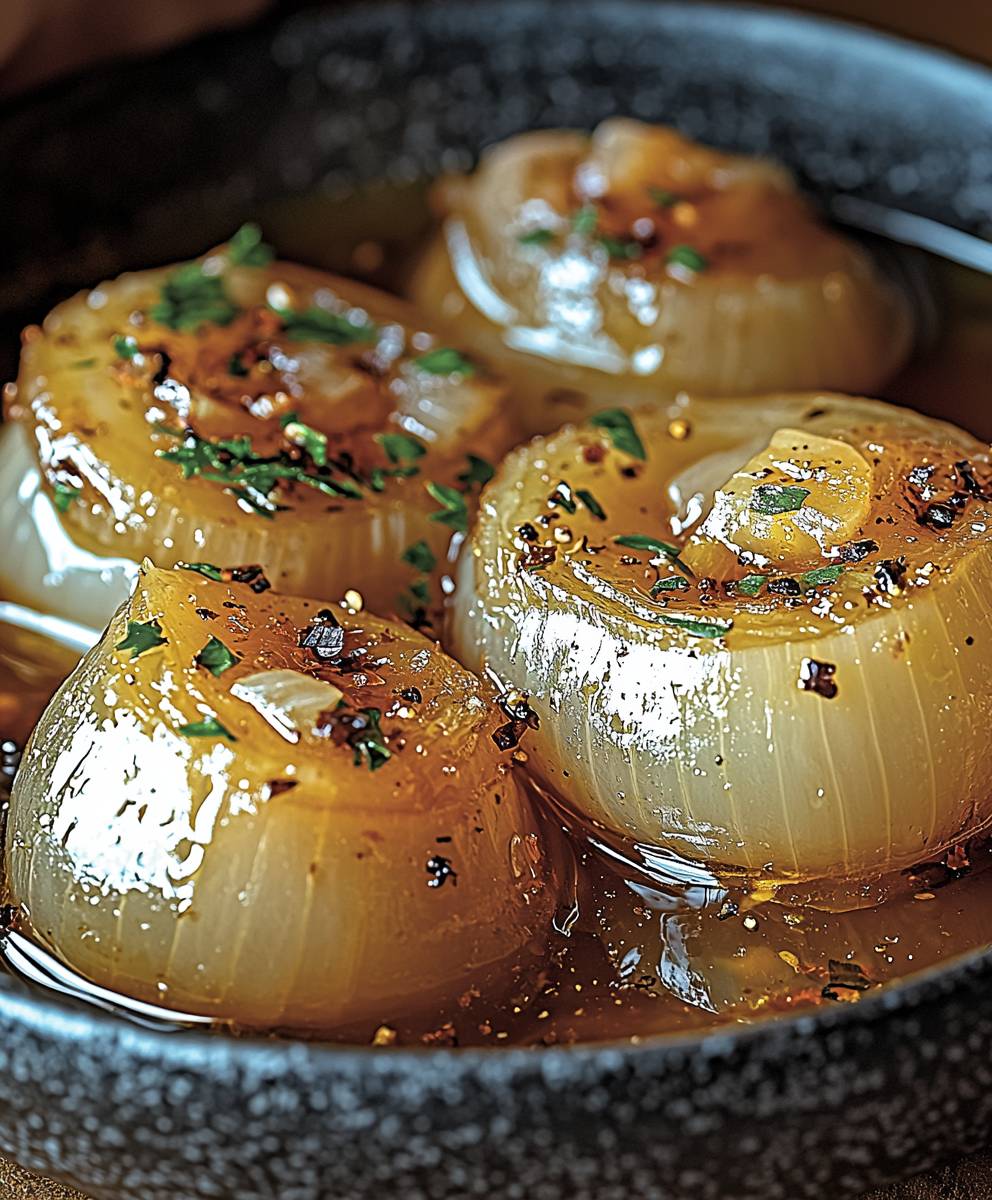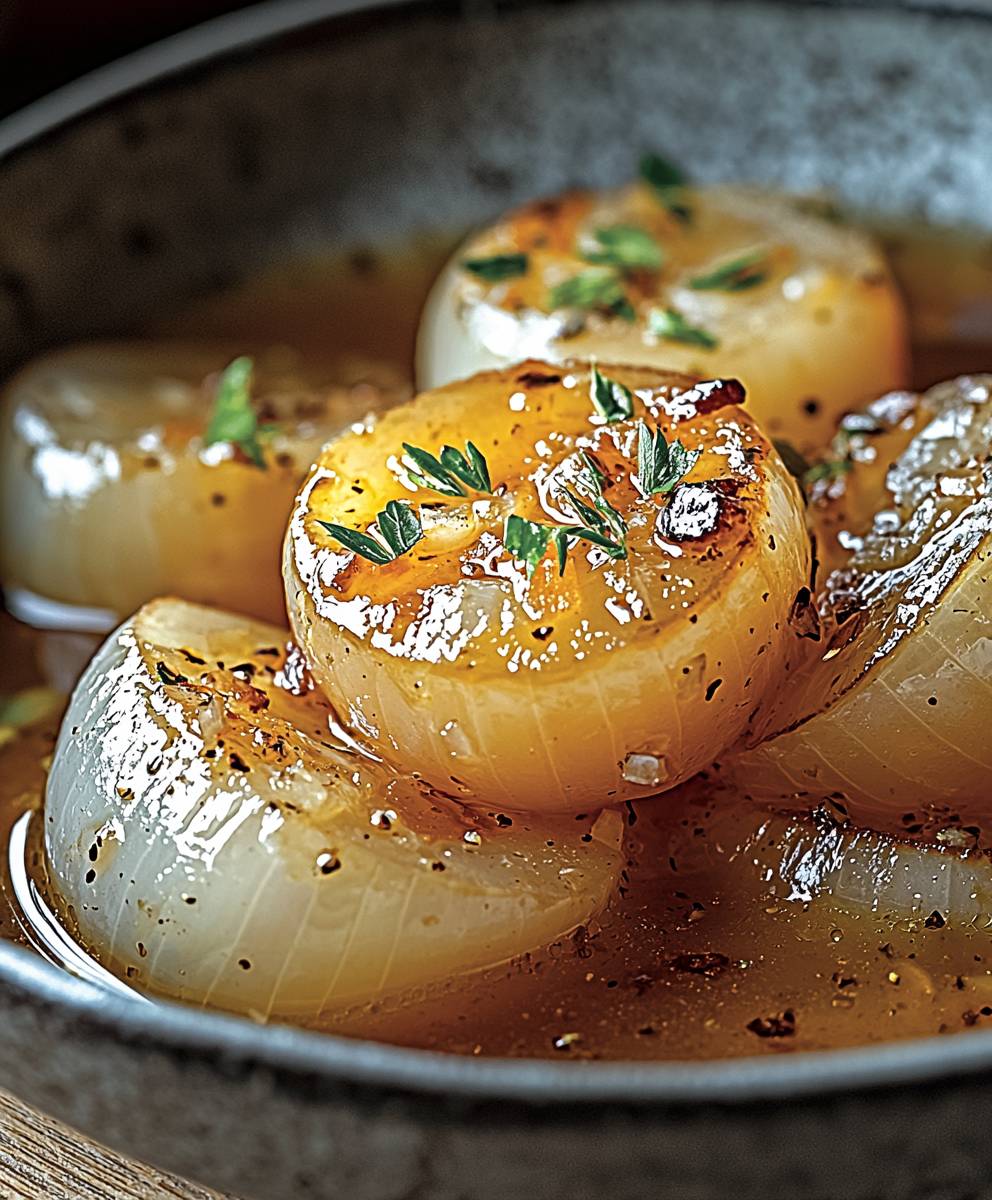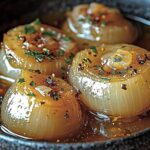Boiled Onions: Prepare to be pleasantly surprised! I know what you’re thinking boiled onions? Really? But trust me, this humble dish is a culinary secret weapon, a blank canvas for flavor, and a surprisingly delicious side that deserves a place on your table. Forget everything you thought you knew about bland, mushy onions. We’re about to elevate this simple vegetable to something truly special.
While not steeped in ancient history like some dishes, boiled onions have long been a staple in resourceful kitchens around the world. They represent a thrifty and practical way to utilize a readily available vegetable, particularly during times of scarcity. In many cultures, they were a foundational element of soups, stews, and sauces, providing a subtle sweetness and depth of flavor. Think of them as the unsung heroes of comfort food!
So, why do people love this seemingly simple dish? Well, for starters, boiled onions are incredibly versatile. Their mild, slightly sweet flavor pairs beautifully with a wide range of proteins and other vegetables. They’re also incredibly easy to prepare, making them a perfect weeknight side dish. And let’s not forget the texture when cooked properly, they become meltingly tender, a delightful contrast to the often-crisp textures of main courses. Plus, they are a fantastic way to add nutrients to your meal. Get ready to rediscover the magic of boiled onions!

Ingredients:
- 2 large yellow onions, peeled
- 4 cups vegetable broth (or chicken broth for a richer flavor)
- 2 tablespoons olive oil
- 1 teaspoon salt, or to taste
- ½ teaspoon black pepper, freshly ground
- 1 bay leaf
- 2 sprigs fresh thyme (optional)
- 1 clove garlic, minced (optional)
- 1 tablespoon butter (optional, for extra richness)
- Fresh parsley, chopped (for garnish)
Preparing the Onions:
- First, grab your onions. Make sure they’re peeled! You don’t want any of that papery skin in your final dish. I usually give them a quick rinse under cold water after peeling just to remove any lingering bits.
- Now, you have a choice. You can boil the onions whole, halved, or quartered. Boiling them whole will take the longest, but it results in a beautifully intact onion. Halving or quartering them speeds up the cooking process. For this recipe, I’m going to halve them. Simply cut each onion in half from top to bottom, through the root end.
The Boiling Process:
- In a large pot, combine the vegetable broth (or chicken broth), olive oil, salt, pepper, bay leaf, and thyme sprigs (if using). The broth is going to infuse the onions with flavor as they cook, so don’t skimp on the quality! I prefer vegetable broth for a lighter, more delicate flavor, but chicken broth adds a lovely richness.
- Bring the broth mixture to a boil over medium-high heat. Once it’s boiling, gently add the halved onions to the pot. Make sure they’re mostly submerged in the broth. If not, add a little more broth or water until they are.
- Reduce the heat to low, cover the pot, and simmer for 45-60 minutes, or until the onions are very tender and easily pierced with a fork. The exact cooking time will depend on the size and variety of your onions. Check them periodically to make sure they’re not overcooking and falling apart. You want them to be tender but still hold their shape.
- After about 45 minutes, start checking the onions for tenderness. Insert a fork into the center of one of the onion halves. If it slides in easily with little resistance, they’re ready. If not, continue simmering for another 10-15 minutes and check again.
- Once the onions are cooked through, carefully remove them from the pot using a slotted spoon. Place them on a plate to cool slightly. Discard the bay leaf and thyme sprigs.
Optional: Sautéing for Extra Flavor:
This step is totally optional, but I highly recommend it! Sautéing the boiled onions in a little butter and garlic adds a beautiful caramelized flavor and a lovely golden-brown color.
- In a large skillet, melt the butter over medium heat. If you’re using garlic, add the minced garlic to the skillet and sauté for about 30 seconds, or until fragrant. Be careful not to burn the garlic!
- Add the boiled onions to the skillet and sauté for 5-7 minutes, or until they’re lightly browned and caramelized. Turn them occasionally to ensure even browning.
- Season with a little extra salt and pepper to taste.
Serving:
- Transfer the boiled (or sautéed) onions to a serving dish.
- Garnish with fresh chopped parsley.
- Serve immediately. Boiled onions are delicious as a side dish with roasted meats, poultry, or fish. They’re also great added to soups, stews, or casseroles.
Tips and Variations:
- Sweet Onions: For a sweeter flavor, use sweet onions like Vidalia or Walla Walla.
- Broth Options: You can experiment with different types of broth to change the flavor profile. Beef broth would add a richer, more savory flavor.
- Herbs and Spices: Feel free to add other herbs and spices to the broth, such as rosemary, oregano, or a pinch of red pepper flakes for a little heat.
- Balsamic Glaze: Drizzle the boiled onions with a balsamic glaze for a sweet and tangy flavor.
- Creamy Sauce: For a richer dish, you can make a simple cream sauce by adding a splash of heavy cream to the skillet while sautéing the onions.
- Wine: Add a splash of dry white wine to the broth for added depth of flavor.
- Caramelized Onions: For a deeper, sweeter flavor, continue sautéing the onions until they are deeply caramelized. This will take longer, about 20-30 minutes, but it’s well worth the effort!
- Make Ahead: You can boil the onions ahead of time and store them in the refrigerator for up to 3 days. Sauté them just before serving.
- Vegan Option: Ensure you are using vegetable broth and olive oil instead of butter to keep this recipe vegan.
Troubleshooting:
- Onions are not tender enough: If the onions are still firm after 45 minutes, continue simmering them for longer, checking every 10-15 minutes.
- Onions are falling apart: If the onions are overcooked and falling apart, remove them from the pot immediately. They may still be edible, but they won’t look as pretty.
- Broth is too salty: If the broth is too salty, add a little water to dilute it.
- Broth is not flavorful enough: If the broth is not flavorful enough, add more herbs and spices, or a splash of wine.
Serving Suggestions:
- Serve as a side dish with roasted chicken, pork, or beef.
- Add to soups, stews, or casseroles.
- Serve on top of crostini with goat cheese.
- Use as a topping for pizza or flatbread.
- Add to omelets or frittatas.
Enjoy your perfectly boiled onions! I hope you find this recipe helpful and delicious. Let me know in the comments if you have any questions or suggestions.

Conclusion:
So there you have it! This isn’t your grandma’s bland, mushy boiled onion recipe. This is a transformation, a revelation in simplicity. I truly believe that once you try this method, you’ll never look at onions the same way again. The subtle sweetness, the tender texture, and the sheer versatility make this boiled onions recipe a must-try for anyone looking to elevate their everyday cooking. Why is it a must-try? Because it’s incredibly easy, uses minimal ingredients, and unlocks a flavor profile you probably didn’t even know existed within the humble onion. It’s a fantastic way to introduce more vegetables into your diet, and it’s a budget-friendly option that doesn’t compromise on taste. Plus, it’s a blank canvas for culinary creativity! Now, let’s talk serving suggestions and variations, because the possibilities are truly endless. For a simple side dish, toss the boiled onions with a knob of butter, a sprinkle of fresh herbs like parsley or thyme, and a pinch of sea salt and freshly ground black pepper. This is a classic combination that never fails to impress. But don’t stop there! These tender onions are fantastic in omelets and frittatas, adding a touch of sweetness and depth. Chop them up and add them to your favorite quiche recipe for an extra layer of flavor. They’re also incredible in soups and stews, melting into the broth and adding a subtle richness. Feeling adventurous? Try caramelizing the boiled onions in a pan with a little balsamic vinegar for a sweet and tangy topping for bruschetta or crostini. Or, blend them into a creamy onion soup for a comforting and flavorful meal. You could even add them to your next batch of mashed potatoes for a unique and delicious twist. For a heartier meal, serve the boiled onions alongside roasted chicken, pork, or beef. The sweetness of the onions complements the savory flavors of the meat perfectly. You can also use them as a filling for savory tarts or pies. And if you’re looking for a vegetarian option, try serving the boiled onions with a dollop of creamy goat cheese and a drizzle of honey. The combination of sweet, savory, and tangy is simply divine. Don’t be afraid to experiment with different herbs and spices to customize the flavor to your liking. A pinch of smoked paprika adds a smoky depth, while a dash of red pepper flakes adds a touch of heat. A squeeze of lemon juice brightens up the flavor and adds a zesty kick. I’m so excited for you to try this recipe and discover the magic of perfectly boiled onions. I truly believe it will become a staple in your kitchen. So, what are you waiting for? Gather your ingredients, follow the simple steps, and prepare to be amazed. And most importantly, don’t forget to share your experience with me! I’d love to hear how you enjoyed the recipe, what variations you tried, and what dishes you created with your perfectly boiled onions. Leave a comment below, tag me in your social media posts, or send me an email. I can’t wait to see what culinary creations you come up with! Happy cooking! Print
Boiled Onions: Benefits, Uses, and Simple Recipe
- Total Time: 50-75 minutes
- Yield: 4–6 servings 1x
Description
Tender boiled onions simmered in broth with herbs and spices. Optional sauté for caramelized flavor. Versatile side dish or ingredient.
Ingredients
- 2 large yellow onions, peeled
- 4 cups vegetable broth (or chicken broth for a richer flavor)
- 2 tablespoons olive oil
- 1 teaspoon salt, or to taste
- ½ teaspoon black pepper, freshly ground
- 1 bay leaf
- 2 sprigs fresh thyme (optional)
- 1 clove garlic, minced (optional)
- 1 tablespoon butter (optional, for extra richness)
- Fresh parsley, chopped (for garnish)
Instructions
- Prepare Onions: Peel onions and rinse. Halve or quarter them (halving recommended).
- Boil Onions: In a large pot, combine broth, olive oil, salt, pepper, bay leaf, and thyme (if using). Bring to a boil over medium-high heat.
- Gently add onions to the pot, ensuring they are mostly submerged. Add more broth or water if needed.
- Reduce heat to low, cover, and simmer for 45-60 minutes, or until onions are very tender and easily pierced with a fork. Check periodically.
- Remove onions with a slotted spoon and place on a plate to cool slightly. Discard bay leaf and thyme.
- Optional Sauté: Melt butter in a large skillet over medium heat. Add garlic (if using) and sauté for 30 seconds until fragrant.
- Add boiled onions to the skillet and sauté for 5-7 minutes, or until lightly browned and caramelized, turning occasionally. Season with extra salt and pepper.
- Serve: Transfer onions to a serving dish. Garnish with fresh parsley. Serve immediately.
Notes
- For a sweeter flavor, use sweet onions like Vidalia or Walla Walla.
- Experiment with different types of broth to change the flavor profile. Beef broth would add a richer, more savory flavor.
- Feel free to add other herbs and spices to the broth, such as rosemary, oregano, or a pinch of red pepper flakes for a little heat.
- Drizzle the boiled onions with a balsamic glaze for a sweet and tangy flavor.
- For a richer dish, you can make a simple cream sauce by adding a splash of heavy cream to the skillet while sautéing the onions.
- Add a splash of dry white wine to the broth for added depth of flavor.
- For a deeper, sweeter flavor, continue sautéing the onions until they are deeply caramelized. This will take longer, about 20-30 minutes, but it’s well worth the effort!
- You can boil the onions ahead of time and store them in the refrigerator for up to 3 days. Sauté them just before serving.
- Ensure you are using vegetable broth and olive oil instead of butter to keep this recipe vegan.
- Prep Time: 5 minutes
- Cook Time: 45 minutes




Leave a Comment